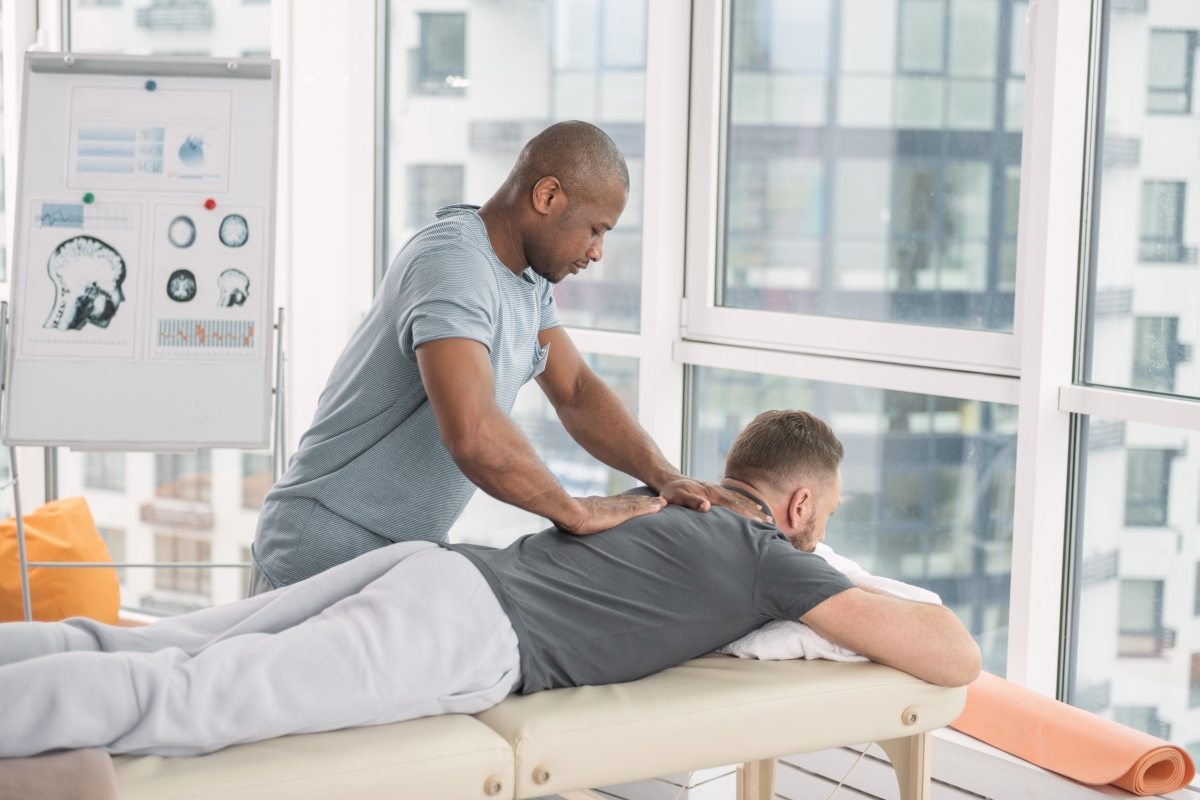Career Overview
Massage therapists assess and treat soft tissues and joints of the body. Their work helps improve and maintain good health and treat pain from injuries and physical disorders. In B.C., all massage therapists are registered.
Job Titles
Duties
In general, registered massage therapists (RMTs):
- Interview patients and take medical histories
- Assess patients using range-of-motion and muscle tests, muscle palpation, gait assessment and orthopedic testing
- Monitor vital signs
- Develop treatment plans
- Explain procedures, risks and benefits
- Use massage techniques such as hands-on soft tissue treatment, relaxation, hydrotherapy, joint play mobilizations and stretching
- Teach patients how to do at-home exercises
- Offer tips for daily living
- Keep records of treatments
RMTs may consult with other members of a patient’s health care team such as physiotherapists, chiropractors, physicians and psychologists. They may also refer patients to other health-care professionals.
Earnings
Earnings is income that workers receive in exchange for their labour. Depending on the type of employment, earnings can be in the form of wages (hourly), salaries (fixed monthly or annual) or self-employed earnings.
Work Environment
# Workers Employed
6,525% Employed Full Time
13%Registered massage therapists (RMTs) often work in private practice, either on their own or as part of a team. Or they may work in hospitals, clinics that offer a variety of health-care services, extended care facilities, rehabilitation centres, sports organizations or educational institutions.
Many RMTs work a 35- to 40-hour week. Others work part time. Hours may include evenings and weekends, depending on office hours and patients’ needs. Emergencies can arise but do so less often than in other health-care fields.
The work can be physically demanding. RMTs work with their arms and hands, and they stand for long periods of time.
RMTs use computers for online booking, charting and billing, as well as for the online coursework required to stay certified.
Self-employed RMTs must spend part of their time managing their business, including booking appointments and doing accounting and laundry.
Career Pathways
Registered massage therapists usually begin working in massage therapy clinics, rehabilitation centres, clinics that offer a variety of health-care services, fitness clubs or spas.
With experience, they can become supervisors or start their own business. Some may teach postgraduate continuing education courses or become instructors at accredited massage therapy colleges.
Occupational Interests
It’s important to understand what kinds of occupations align with your interests.
For more about occupational interests visit Skills for the Future Workforce > Characteristics.
Here are the top occupational interest(s) for this career profile:
Education, Training and Skills
In B.C., registered massage therapists (RMTs) are regulated health professionals with primary care provider status. They are governed and certified by the College of Massage Therapists of British Columbia (CMTBC).
To become certified, they must:
- Complete a two-year massage therapy program from an accredited school, including supervised practical training
- Pass written and practical exams
- Be certified in standard First Aid Level C and CPR
- Pass a background check
RMTs must renew their registration with CMTBC every year.
Some registered massage therapists do additional training in specific areas of practice. RMTs who have full-time experience specializing in sport massage can take an exam to get certified through the Canadian Sport Massage Therapists Association (CSMTA).
Massage therapists who are certified for that occupation by a regulator elsewhere in Canada can apply for the same certification from the regulator in B.C. Under the terms of the Canadian Free Trade Agreement (CFTA), most applicants who are transferring their credentials from elsewhere in Canada will not be required to complete additional training or testing. However, the B.C. regulator may ask applicants to provide further information such as a letter of good standing, references, or criminal record check.
For those who trained outside of Canada and never received certification from any Canadian jurisdiction, a full assessment is likely needed. Most occupational regulators have a process for assessment and recognize internationally trained applicants.
Contact the College of Massage Therapists of British Columbia (CMTBC) for details on how to apply for certification in B.C.
For information about labour mobility in Canada, visit www.workersmobility.ca.
View a list of Professional Regulatory Authorities in B.C.
Education programs in B.C.

Top Skills
Every job calls for a certain set of skills. Knowing those skills is the first step in finding a good career fit.
Here, you will find the 10 most relevant workplace skills. Some are more important to achieving success in a certain career than others. These skills may come naturally to you or you may need to gain them through education, training and experience.
See the list of work-related skills below, ranked in order of importance for this career. Check out the list and see if this career matches your skills—take that first step!
Talking to others to share information effectively.
Giving full attention to what other people are saying, taking time to understand the points being made, asking questions as appropriate, and not interrupting at inappropriate times.
Being aware of others’ reactions and understanding why they react as they do.
Actively looking for ways to help people.
Considering the relative costs and benefits of potential actions to choose the most appropriate one.
Using logic and reasoning to identify the strengths and weaknesses of alternative solutions, conclusions or approaches to problems.
Understanding written sentences and paragraphs in work-related documents.
Understanding how new information could be used to solve current and future problems in making decisions.
Keeping track of and assessing your performance, other individuals, or organizations to make improvements or take corrective action.
Communicating effectively in writing as appropriate for the needs of the audience.
Labour Market Statistics
Discover data, facts and information that have been gathered and analyzed. Learn about the characteristics of the economy and labour market in B.C.
Employment
Find out about employment types and trends by region and industry.
Employment
6,525Employment by Region







| Region | Employment | % Employment of this Occupation |
|---|---|---|
| Cariboo | 130 | 2.0% |
| Kootenay | 300 | 4.6% |
| Mainland/Southwest | 3,810 | 58.4% |
| North Coast and Nechako | 100 | 1.5% |
| Northeast | 30 | 0.5% |
| Thompson-Okanagan | 805 | 12.3% |
| Vancouver Island/Coast | 1,350 | 20.7% |
Labour Market Outlook
The B.C. Labour Market Outlook is a 10-year forecast of the expected supply and demand for labour in the province. It’s usually updated every year. The purpose is to provide British Columbians with the knowledge to make informed decisions on careers, skills training, education and hiring.
Forecasted Job Openings (2025-2035)
3,700Forecasted Job Openings
Forecasted Employment Growth Rate
Composition of Job Openings
Job Openings by Region (2025-2035)







| Region | Job Openings | Avg. Annual Employment Growth |
|---|---|---|
| Cariboo | 60 | 2.1% |
| Kootenay | 200 | 2.1% |
| Mainland/Southwest | 2,190 | 2.1% |
| North Coast and Nechako | 50 | 2.5% |
| Northeast | 10 | 1.2% |
| Thompson-Okanagan | 450 | 2.0% |
| Vancouver Island/Coast | 730 | 2.3% |
Industry Highlights
Learn about the opportunities in B.C.'s major industries, including employment trends, earning potential, locations of work and more.
Forecasted Job Openings by Industry
| Industry | Job Openings (2025-2035) |
|---|---|
| Health Care and Social Assistance | 3,270 |
| Repair, Personal and Non-Profit Services | 370 |
| Educational Services | 30 |
| Accommodation and Food Services | 30 |
| Professional, Scientific and Technical Services | 10 |
Insights from Industry
As the number of accredited schools in B.C. has increased, the supply of registered massage therapists (RMTs) has risen. The supply also continues to grow as massage therapists transfer to B.C. from other provinces.
Demand for RMTs has also grown, as more spas open and new rules let patients visit RMTs without a doctor’s referral. Demand is expected to increase further as the economy grows.
Rural and isolated areas of central and northern B.C. will likely have the highest need for RMTs.
Resources
-
B.C. Ministry of Healthwww.gov.bc.ca/health/
-
Canadian Massage Therapist Alliance (CMTA)www.crmta.ca/
-
Canadian Sport Massage Therapists Association (CSMTA)www.csmta.ca/
-
College of Massage Therapists of British Columbia (CMTBC)cmtbc.ca/
-
Federation of Massage Therapy Regulatory Authorities of Canada (FOMTRAC)www.fomtrac.ca/
-
Registered Massage Therapists Association of BC (RMTBC)www.rmtbc.ca/








